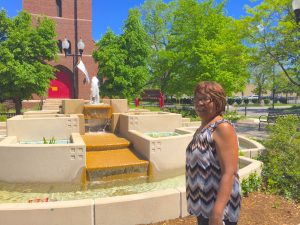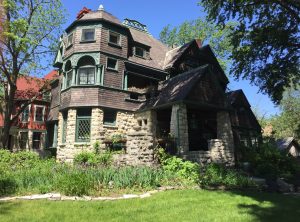Food, conversation build bridges between Oak Park, Austin neighborhood
By Jean Lotus Staff reporter — May 22, 2017
Sandra Broadwater poses in front of the two-flat her family has owned since the 1980s. (Chronicle Media).
Creating a regional meme — “Greater West Side” — is one way to break down the barriers between the Austin neighborhood in Chicago and the Village of Oak Park, according to a long-time Oak Park desegregation activist.
“It’s a concept that we’ve been naming and talking about well over a year, at least two years,” said Rob Breymaier, executive director of the Oak Park Regional Housing Center.
About 170 people from both communities took part in an On the Table conversation about bridging the two communities May 16 at the 1920s-era Columbus Park Refrectory.
The two communities, separated by a single north-south boulevard, have significant differences. Oak Park is an upper middle-class village populated by around 52,000 residents packed into 4.6 square miles, according to 2014 population figures. Austin, a low-income neighborhood of Chicago, is much larger, with 99,711 residents in a 7-square-mile area.
Median household income in Oak Park was $82,518 in 2015, while Austin’s median household income was $31,435. The state median income was $59,600.
Approximately 63 percent of Oak Parkers are white, with 20 percent African-American, 7 percent Latino and 5 percent Asian. Across Austin Boulevard in Austin, 84 percent of residents are African-American and 10 percent Latino, with only 4 percent white.
From home values to school test scores to crime, the two communities are adjacent but starkly dissimilar in many ways.
But over fried chicken, salad and peach cobbler, participants were encouraged to talk honestly about race and about the ways the two communities could find common ground.
“All our best and brightest have moved away and they never claim the West Side,” said Sharon Davis. “Lupe Fiasco is a multi-millionaire and he never says he’s from the neighborhood.”

Austin resident Ernestine Poe points out the fountain at the end of on Midway Park near St. Martin’s Episcopal Church in the Austin Historic District. (Chronicle Media).
Participants discussed how different local governments broke up the two communities from different school systems and city vs. village government and different police forces. The groups agreed that the two communities shared similarities like the “block club culture.”
The artificial barrier between the two communities is manmade and can be broken down with “intentional integration, inclusion and equality,” Breymaier said.
Breymaier blamed the contrasts specifically on a history of racial segregation in Chicago, which Oak Park resisted with “planned integration” for more than 40 years.
“This is not easy work,” said Resheeda Washington, proprietor of Oak Park’s L!ve Café and executive director of Community First Association. “These things take time.”
Washington said the community had to give input as neighborhoods changed and improved so that residents weren’t displaced by “the G Word — Gentrificaton!”
On the Table conversations are group discussions supported by grants from the Chicago Community Trust.

Austin resident Ernestine Poe points out the fountain at the end of on Midway Park near St. Martin’s Episcopal Church in the Austin Historic District. (Chronicle Media).
Longtime Austin residents love their neighborhoods and want to see more opportunity in the area, they say.
Ernestine Poe, an Austin resident, moved to her blond brick two-flat in Austin’s historic district in the 1980s, which makes her “ a newcomer around here,” in a neighborhood of old-timers, she said. Across the street stand a row of historic Victorian mansions, including the 1886 F.R. Schock Queen Anne, designated a Chicago Landmark in 1999.
Retired from a 42-year banking career, Poe said her neighbors on Midway Park, just north of Lake Street, are seeing grown children come back to the neighborhood and moving into the family homes.
“We just hang on, that’s all we can do,” she said. “We were blessed, that’s all.”
Poe’s family owns rental property that they have listed with Austin Ascending, an offshoot of the Regional Housing Center that provides grants to improve apartments in Austin “in order to promote it as a desirable community where people of all races can live together.”
Poe is the daughter of participants in the Great Migration; her African-American parents and grandmother came north from Arkansas and Mississippi.
“I’ve lived all my life in Chicago,” she said. But she said she did not send her three sons, now in their 30s, to Chicago Public Schools in Austin.
Near the Root Riot Community Garden at the end of the street, neighbors David and Caroline Ioder are cleaning up after the birth of twin baby goats on their urban farmette behind the house. They’ve raised goats and chickens in Austin since 2003.
“Gang-bangers drive past in the alley in their big cars and they slam on the breaks when they see the goats.” said Caroline, who is white. “They ask me ‘What is that?’ and I tell them it’s a goat. They take pictures with their phones,” she said. “I call it the new drive-by shooting.” The Ioders host goat days at the community garden where neighbors can “milk and mingle.” For $20, you can try “yoga with baby goats,” Caroline said. “It’s something that’s happening all over the country. We’re the first in Chicago,” Caroline added.
Neighbor Sandra Broadwater and her husband raised children in Austin and owned a dry cleaner business in Oak Park, until the rent got too high, she said.
“I was paying rent and taxes on a building that cost more than if I bought a building myself, so that’s what we did.” The family moved their business to Chicago Avenue in Austin. Like the Poe family, Broadwater now has a grown child living in the family two-flat.

David Ioder holds a baby goat from his family’s Glenn Art mini-farm in Austin. (Photo courtesy of Caroline Ioder)
Breymaier’s organization has been working to popularize the concept of the Greater West Side with the Community of Congregations interfaith organization, the Austin Weekly News and the Leaders Network, a clergy and community partnership.
“There are a lot of differences between Oak Park and Austin, but we share the same aspirations,” Breymaier said. Partnering together as the Greater West Side could be helpful to acquire resources and infrastructure from the city and county, which often focus on the north and south sides, he said. An example might be working together to lobby for public transportation improvements, like the Green Line, which cuts through both communities.
“Our two communities are linked together and we can’t survive without each other. Race is a determining factor in how people look for neighborhoods in Chicago and that’s the driving force behind what creates disparities in opportunities,” Breymaier said. Bringing racial diversity to Austin, in the form of more white and Hispanic residents, but without block busting or gentrification, will boost the region.
“It turns out over 45 years we’ve learned intentional integration ends up being really smart for economic development. Opportunities increase for everyone when you have inclusion and racial harmony over time.”
— Food, conversation build bridges between Oak Park, Austin neighborhood —








